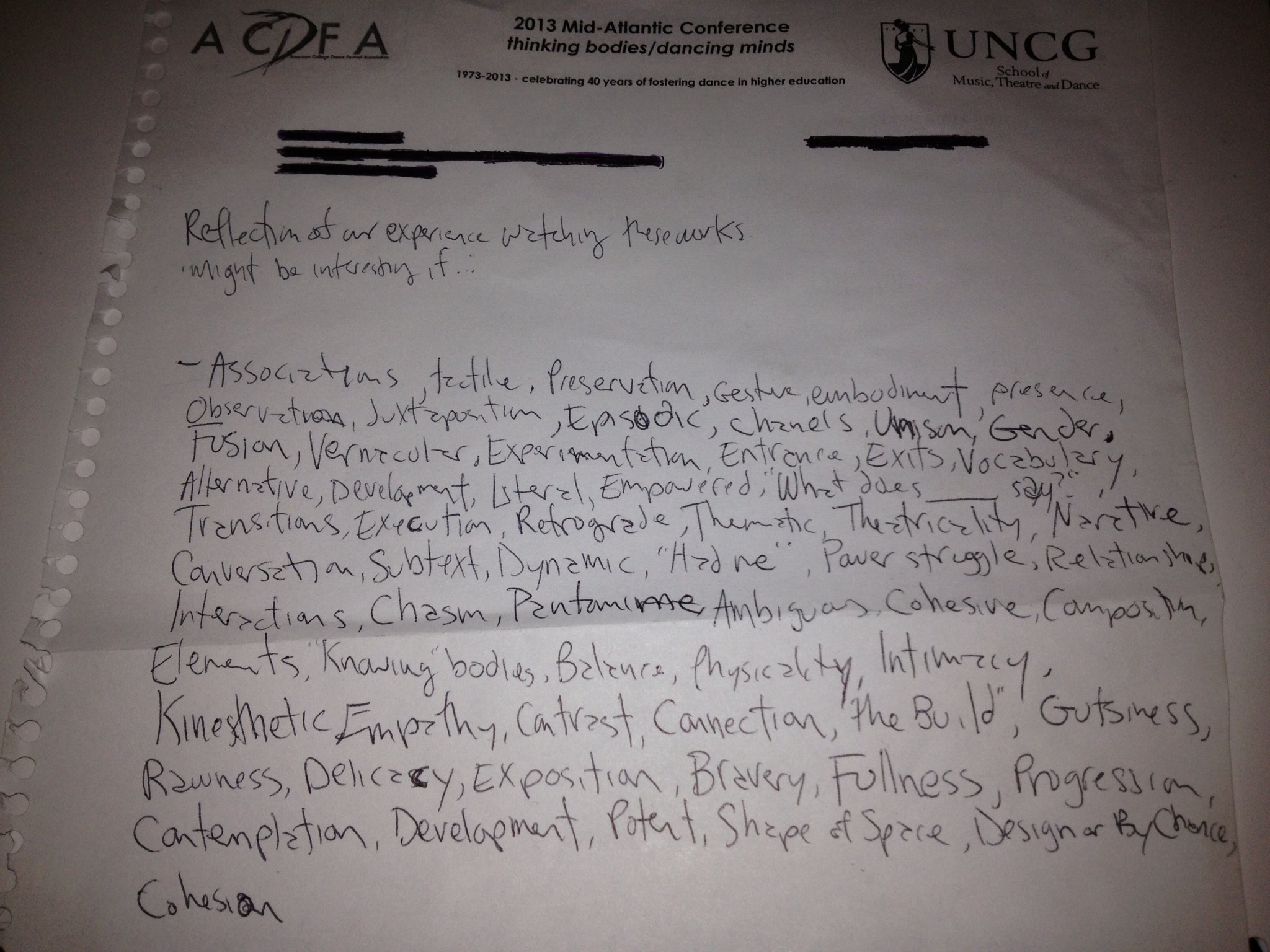Contributed by Maxx Passion
I am a first year MFA student in Dance Composition at the University of Michigan, Ann Arbor, and this past March I attended the American College Dance Festival Association’s (ACDFA) 40th anniversary conference, which was held at the University of North Carolina at Greensboro. Four first year graduate students accompanied ten sophomore, junior and senior BFA students to this four-day conference. ACDFA is a way for colleges and universities from around the country to come together to take class, present dance work in both formal and informal showings, and generally see what everyone else is up to. As a graduate student, I was not only taking class, but teaching as well. I was also asked to sit on a panel of faculty members to watch one of the informal concerts, and provide verbal feedback to the student and faculty choreographers who presented work.
I enrolled in Melanie Yergeau’s Computers & Writing course (along with an MFA poet and PhD students from the Joint Program in English and Education) because my thesis work explores composition for both stage and online/onscreen. This class has given me the opportunity to discuss creation and composition with people who are outside of my genre, but it has taken me by surprise that my colleague’s main concern about including multimodal/digital composition in their classroom is how to assess and give feedback on a creative project. For dancers, it is common practice to both give and receive peer-to-peer or faculty to student feedback about composition and choreography. I now realize that I have taken this assessment experience for granted. I found myself using terminology and aesthetic discourse during class discussions on readings and online multimodal/digital compositions that I would use if I were giving feedback about a dance work. If my colleagues are searching for a metalanguage in order to discuss and assess digital compositions, why not apply the language that already exists for inherently multimodal and interdisciplinary arts such as dance/dance making? What follows are two examples of ways to make connections between the metalanguage of dance composition and interdisciplinary composition in the English classroom.
As mentioned earlier, I had been asked to sit on a panel of an informal concert at ACDFA and give feedback about the work presented. This was the perfect opportunity to put my ideas into action as to whether choreographic feedback could speak to a community outside of the dance world. During this feedback session, I decided to record words that my fellow panelists were using to describe what they experienced during each performance, and then share them with my classmates upon my return.
Here is a photograph of the words collected:

There are some words listed that are obviously dance-specific: kinesthetic awareness, retrograde, shape of space and physicality. However, there are a number of words that I believe can easily be navigated into a conversation about composition of all kinds. I asked my classmates to take a look at my compiled list, and pick out any words that they either already use in their classroom for creative assessments, or that they find particularly intriguing as words that might apply to an English composition classroom.
Here is what they gave me:
(words in bold were listed by more than one classmate):
empathy, delicacy, bravery, gesture, embodiment, subtext, juxtaposition, balance, intimacy, cohesion, contrast, theatricality, ambiguity, association, transitions, design, fusion, entrance/exit, subtext, interactions, connection
Many of the words chosen by my classmates had performative connotations, which makes sense if we are searching for how to discuss a visual representation of creative ideas. And while there isn’t a concrete answer to how each of these words might find their way into a conversation about multimodal/digital composition, there are a couple of exciting possibilities. Here are a few of my thoughts:
Delicacy: I find that the idea of delicacy doesn’t always have to do with the intention of performance, but how light (or heavy) a hand the creator uses while putting together their media.
Ambiguity: I believe that ambiguity has the potential for a positive description. The right amount of ambiguity can provide the audience with wiggle-room to make decisions about reason and meaning on their own. Ambiguity can be a powerful device when used appropriately.
Entrance/Exit: These two words can be taken very literally for the stage, but when composing digitally, it is very important to be mindful of how to transition between media; a well-placed cut on action, or fade-in/out are important details that can change the look and feel of a project.
My experience at ACDFA did not warrant graded results of course, but it provided the perfect opportunity to gather a list of words that give an embodied indication about what is seen, heard and felt about a composition. By finding ways to tap into vocabulary from outside mediums of written compositions, a teacher who might be in new territory speaking about non-written work can find ways to articulate themselves to their students.
There was extraordinary work created by the young dancers attending ACDFA; dances that were thought provoking and provocative, complex and dynamic, funny and grounded, collaborative and solo projects, and I was tasked to speak on it all. Of course there were performances that I found more compelling than others, but regardless of what I found aesthetically appealing, I was still responsible for articulating to the dancers and choreographers not only what I saw, but also, how their compositional choices affected the audience